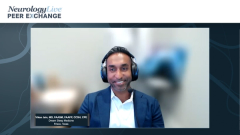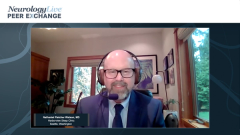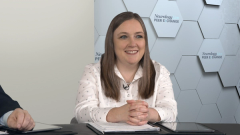
Optimizing a Diagnostic Work-up of Insomnia
Considerations for how to optimally work up and diagnose patients with insomnia.
Episodes in this series

Transcript:
Michael J. Thorpy, MD: Erinn, when a patient comes to you with a complaint about insomnia, what are you going to do in your office to evaluate this?
Erinn E. Beagin, MD: The nice thing about insomnia is that it’s diagnosable by the internist, I don’t need to have a referral or an extra test. It’s history, which good internists should be outstanding at. It’s talking to the patient, getting a history, getting more details. There are always some recall issues. Get them to provide a sleep diary and tell them what you want in a sleep diary. Get more standardized questions. Look for other comorbid conditions. “Has your COPD [chronic obstructive pulmonary disease] been well controlled? Has your depression and anxiety [been controlled]? Has something happened at home?” Are there any other identifiable causes that we can treat at the same time? Use standardized questionnaires, such as the Pittsburgh Sleep Quality Index. That’s a bit cumbersome in a 10- to 15-minute visit, but it’s something the patient could take home. Or if they call saying, “I have anxiety, and I have sleep issues. I want to come in and talk to the doctor,” have the staff send that to them. I’d be able to look at it before going in.
The biggest thing is asking about quality of life, not focusing on just sleep. That’s definitely a problem but how are you doing. Are you functioning, are doing well at school, are you having accidents, are you missing things at work? If you’re an accountant and your calculations are slightly off, that’s going to be a huge issue. Are you worried all day that you’re going to make a mistake? That’s a big fear. People are afraid that they’re not functioning as well as they should. They probably are, but they’re always worried about it. “I’m not on top of my game. I don’t feel confident. I’m a school bus driver. I don’t feel as confident as I should be that I’m going to have the reaction times.” Focus on that how are you doing with this.
Then look at what you’ve tried, what’s worked, what hasn’t worked. A lot of times people who come to me have tried over-the-counter medication. They’ve even tried they’re mother’s, father’s, sister’s, cousin’s, or friend’s medications. They may have tried other medications in the past if other doctors have given them things, but they haven’t brought it up because they didn’t like the adverse effects, or it didn’t work. Get a history of how long it’s been going on. “What’s affecting your life? What have you done about it, and what are you hoping to achieve?” Line up those goals.
Michael J. Thorpy, MD: You mentioned a lot of things. For the primary care physician, he’s often concerned that this is going to take a lot of time, and he’s dealing with diabetes and hypertension. But does he need to take a lot of time as a primary care physician to assess somebody’s insomnia?
Erinn E. Beagin, MD: A of time? No. The correct attention to it? Yes. He has to identify it and recognize that. I’ve seen this in most primary care doctors who pay attention to it. If you’re not addressing their concerns, everything else is going to take much more time. I’m trying to get my patient with diabetes to exercise and eat a healthier diet. But if they’re not sleeping well, then they’re not interested in exercise because they’re tired. Does it need to take a lot of time? No. Does it need to be addressed? Absolutely, because it does filter into all parts of that patient’s life. While I’m banging away trying to get an A1C [glycated hemoglobin] down, that patient isn’t exercising. They’re not interested in cooking. They’re stopping at McDonald’s because they’re not interested. It doesn’t take a lot, but you need to address it.
Michael J. Thorpy, MD: Karl, are there certain things you like to do in the office that have been particularly helpful in that initial evaluation of the patient?
Karl Doghramji, MD: Definitely, Michael. One thing I like to get is the pattern of insomnia over time. Has it waned and waxed? Has it been pretty much the same over time? It gives us some diagnostic information. In addition to the pattern of insomnia during the night, is it an initiation problem or a maintenance problem? Is it a problem falling asleep or staying asleep? That can have diagnostic significance. For example, a person who has difficulty falling asleep for many hours may have a circadian rhythm abnormality, such as a delayed sleep phase syndrome, or may have a phobic preoccupation for sleeplessness or psycho physiological insomnia. A person who wakes up a lot during the night may have a depression, sleep apnea. A person who wakes up early and can’t fall back to sleep may have an advanced sleep phase syndrome. That’s where the pattern may be relevant. In addition, the pattern across the night can tell us what type of treatment might be most appropriate. For example, certain medications are indicated for initiation insomnia. Others are indicated for maintenance insomnia. Others are indicated for both.
One thing we might want to consider in the office is the use inventories, such as sleep logs, to help us track things over the course of time. In some cases, actigraphy, or motion monitors, can help us more objective quantify the pattern of insomnia over many weeks and months. Of course, in sleep specialty offices we tend to use polysomnography or sleep studies in cases where we may want to diagnose sleep apnea or limb movements in sleep, so those symptoms are raised in the office-based evaluation.
Nathaniel Fletcher Watson, MD: Can I jump in for a second? I’d just like to touch on the in-office evaluation a little further. Because technological advancement is creating new opportunities to understand sleep in an ecologically valid manner, longitudinally. What I’m getting at is all these devices that we call consumer sleep technologies, which people wear or contactless monitor people’s sleep night after night. We all know what these things are. You’ve got Fitbit, Whoop, the SleepScore app. All these things are beginning to allow patients to assess their sleep long term. Then they can bring this information to their provider, which can provide some objective information that could be actionable. There’s research out there showing this, particularly with a sleep score map device, which is a radio frequency bedside device that can differentiate people with insomnia from healthy individuals. As more research is done with these technologies, they’re going to become more commonplace as a part of the discussion between a patient and a provider when they address sleep complaints in their offices.
Michael J. Thorpy, MD: Those things certainly can be helpful, but it’s a 2-edge sword. Sometimes people can become obsessed with these types of devices and focus far more on it. That may exacerbate their sleep problems because they’re concerned about a few brief awakenings or arousals, which we know commonly occur in most people without any problems.
Nathaniel Fletcher Watson, MD: You’re referring to orthosomnia. If you do a literature search on that, you get 1 paper that’s a case report of 4 patients in Utah. There’s little other evidence around it. I’ve heard that, Michael, and that’s an interesting thought, because we know that patients who suffer from insomnia can get obsessive about their sleep, and they can have inflated expectations about their sleep. Whether consumer sleep technologies do that is an open question, but it’s an interesting point. I see patients who come in and complain about awakenings during the night. I tell them, “Everybody wakes up a handful of times during the night.” We don’t all sleep like Sleeping Beauty, where we lay our head on the pillow and then we open our eyes in the morning after a perfect night’s sleep. It’s a lot of expectation setting that can be problematic.
Vikas Jain, MD, FAASM, FAAFP, CCSH, CPE: Which is important in general, right? That’s when we go back to even pediatric insomnia. That’s something I sometimes mention to patients, that we’re supposed to wake up in the middle of the night. We check our surroundings. We make sure we’re safe. Our brain is running all these checks, and we go back to sleep. With a lot of children, if you do something that’s completely different from a child’s environment for the rest of the night at bedtime—rock the child to sleep, use a soothing technique, etc—and the kid wakes up and is running through his checklist and something’s not there, what do you thinks going to happen? He’s going to say, “Until you rock me back to sleep, I’m not going to go to bed.” The parents are sitting there all night to do this. It’s important to get some context to the objective data right. That’s very helpful. Sometimes, patients will come in and say, “It’s taking me 2 hours to fall asleep.” I like to ask them, “What do you do during those 2 hours? Are you in bed? Are you out of bed? Are you on your smartphone? That’s emitting bright light that could be affecting your sleep.” Thus, it’s really helpful to get some context.
Transcript edited for clarity.
Newsletter
Keep your finger on the pulse of neurology—subscribe to NeurologyLive for expert interviews, new data, and breakthrough treatment updates.




































